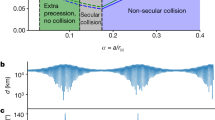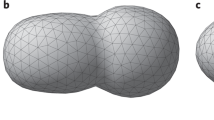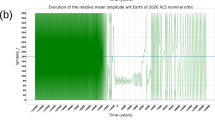Abstract
Asteroids are primitive Solar System bodies that evolve both collisionally and through disruptions arising from rapid rotation1. These processes can lead to the formation of binary asteroids2,3,4 and to the release of dust5, both directly and, in some cases, through uncovering frozen volatiles. In a subset of the asteroids called main-belt comets, the sublimation of excavated volatiles causes transient comet-like activity6,7,8. Torques exerted by sublimation measurably influence the spin rates of active comets9 and might lead to the splitting of bilobate comet nuclei10. The kilometre-sized main-belt asteroid 288P (300163) showed activity for several months around its perihelion 2011 (ref. 11), suspected to be sustained by the sublimation of water ice12 and supported by rapid rotation13, while at least one component rotates slowly with a period of 16 hours (ref. 14). The object 288P is part of a young family of at least 11 asteroids that formed from a precursor about 10 kilometres in diameter during a shattering collision 7.5 million years ago15. Here we report that 288P is a binary main-belt comet. It is different from the known asteroid binaries in its combination of wide separation, near-equal component size, high eccentricity and comet-like activity. The observations also provide strong support for sublimation as the driver of activity in 288P and show that sublimation torques may play an important part in binary orbit evolution.
This is a preview of subscription content, access via your institution
Access options
Access Nature and 54 other Nature Portfolio journals
Get Nature+, our best-value online-access subscription
$29.99 / 30 days
cancel any time
Subscribe to this journal
Receive 51 print issues and online access
$199.00 per year
only $3.90 per issue
Buy this article
- Purchase on Springer Link
- Instant access to full article PDF
Prices may be subject to local taxes which are calculated during checkout



Similar content being viewed by others
References
Marzari, F., Rossi, A. & Scheeres, D. J. Combined effect of YORP and collisions on the rotation rate of small main belt asteroids. Icarus 214, 622–631 (2011)
Pravec, P. & Harris, A. W. Binary asteroid population. 1. Angular momentum content. Icarus 190, 250–259 (2007)
Walsh, K. J., Richardson, D. C. & Michel, P. Rotational breakup as the origin of small binary asteroids. Nature 454, 188–191 (2008)
Walsh, K. J. & Jacobson, S. A. in Asteroids IV (eds Michel, P. et al.) 375–393 (Univ. Arizona Press, 2015)
Jewitt, D. et al. Anatomy of an asteroid breakup: the case of P/2013 R3. Astron. J. 153, 223 (2017)
Hsieh, H. H. & Jewitt, D. A population of comets in the main asteroid belt. Science 312, 561–563 (2006)
Jewitt, D. The active asteroids. Astron. J. 143, 66 (2012)
Jewitt, D., Hsieh, H. & Agarwal, J. in Asteroids IV (eds Michel, P. et al.) 221–241 (Univ. Arizona Press, 2015)
Keller, H. U., Mottola, S., Skorov, Y. & Jorda, L. The changing rotation period of comet 67P/Churyumov–Gerasimenko controlled by its activity. Astron. Astrophys. 579, L5 (2015)
Hirabayashi, M. et al. Fission and reconfiguration of bilobate comets as revealed by 67P/Churyumov–Gerasimenko. Nature 534, 352–355 (2016)
Hsieh, H. H. et al. Discovery of main-belt comet P/2006 VW139 by Pan-STARRS1. Astrophys. J. 748, L15 (2012)
Licandro, J. et al. Exploring the nature of new main-belt comets with the 10.4 m GTC telescope: (300163) 2006 VW139. Astron. Astrophys. 550, A17 (2013)
Agarwal, J., Jewitt, D., Weaver, H., Mutchler, M. & Larson, S. Hubble and Keck telescope observations of active asteroid 288P/300163 (2006 VW139). Astron. J. 151, 12 (2016)
Waniak, W. & Drahus, M. Gemini and Keck observations of slowly rotating, bilobate active asteroid (300163). In AAS/Division for Planetary Sciences Meeting Abstracts Vol. 48, 504.01 (2016)
Novaković, B., Hsieh, H. H. & Cellino, A. P/2006 VW139: a main-belt comet born in an asteroid collision? Mon. Not. R. Astron. Soc. 424, 1432–1441 (2012)
Margot, J.-L., Pravec, P., Taylor, P., Carry, B. & Jacobson, S. in Asteroids IV (eds Michel, P. et al.) 355–374 (Univ. Arizona Press, 2015)
Rotundi, A. et al. Dust measurements in the coma of comet 67P/Churyumov–Gerasimenko inbound to the Sun. Science 347, aaa3905 (2015)
Jacobson, S. A. & Scheeres, D. J. Dynamics of rotationally fissioned asteroids: source of observed small asteroid systems. Icarus 214, 161–178 (2011)
Ćuk, M. & Burns, J. A. Effects of thermal radiation on the dynamics of binary NEAs. Icarus 176, 418–431 (2005)
Jacobson, S. A., Scheeres, D. J. & McMahon, J. Formation of the wide asynchronous binary asteroid population. Astrophys. J. 780, 60 (2014)
Durda, D. D. et al. The formation of asteroid satellites in large impacts: results from numerical simulations. Icarus 167, 382–396 (2004)
Durda, D. D. The formation of asteroidal satellites in catastrophic collisions. Icarus 120, 212–219 (1996)
Vokrouhlický, D., Nesvorný, D. & Bottke, W. F. The vector alignments of asteroid spins by thermal torques. Nature 425, 147–151 (2003)
Hanuš, J. et al. A study of asteroid pole-latitude distribution based on an extended set of shape models derived by the lightcurve inversion method. Astron. Astrophys. 530, A134 (2011)
Cibulková, H., Ďurech, J., Vokrouhlický, D., Kaasalainen, M. & Oszkiewicz, D. A. Distribution of spin-axes longitudes and shape elongations of main-belt asteroids. Astron. Astrophys. 596, A57 (2016)
Vokrouhlický, D. & Ćapek, D. YORP-induced long-term evolution of the spin state of small asteroids and meteoroids: Rubincam’s approximation. Icarus 159, 449–467 (2002)
Schorghofer, N. The lifetime of ice on main belt asteroids. Astrophys. J. 682, 697–705 (2008)
Capria, M. T., Marchi, S., de Sanctis, M. C., Coradini, A. & Ammannito, W. The activity of main belt comets. Astron. Astrophys. 537, A71 (2012)
Johnston, W. R. Binary minor planets V9.0. NASA Planetary Data System 244 (2016)
Hanuš, J. et al. Volumes and bulk densities of forty asteroids from ADAM shape modeling. Astron. Astrophys. 601, A114 (2017)
Kalirai, J. S. et al. WFC3 SMOV Proposal 11450: The Photometric Performance and Calibration of WFC3/UVIS. Instrument Science Report WFC3 2009-31 (November 2009)
Housen, K. R. & Holsapple, K. A. Ejecta from impact craters. Icarus 211, 856–875 (2011)
Bottke, W. F., Nolan, M. C., Greenberg, R. & Kolvoord, R. A. Velocity distributions among colliding asteroids. Icarus 107, 255–268 (1994)
Bottke, W. F. et al. Linking the collisional history of the main asteroid belt to its dynamical excitation and depletion. Icarus 179, 63–94 (2005)
Dressel, L. Wide Field Camera 3 Instrument Handbook for Cycle 25 V9.0 (STScI, 2017)
Finson, M. L. & Probstein, R. F. A theory of dust comets. I. Model and equations. Astrophys. J. 154, 327–352 (1968)
Acknowledgements
This work is based on observations made with the NASA/ESA HST, obtained at the Space Telescope Science Institute, which is operated by the Association of Universities for Research in Astronomy, Inc., under NASA contract NAS 5-26555. These observations are associated with programmes 12597, 14790, 14864 and 14884.
Author information
Authors and Affiliations
Contributions
J.A. identified the potential binary nature of 288P, applied for HST observing time, carried out the model calculations regarding the binary orbit and the dust dynamics, and led the manuscript preparation. D.J. calculated the importance of the sublimation-driven torque and contributed to the interpretation and presentation of the data. M.M. processed the raw images and was responsible for the removal of cosmic rays and the production of the sub-sampled composite images. H.W. contributed to designing and preparing the observations. S.L. checked the work and critiqued the proposals and paper.
Corresponding author
Ethics declarations
Competing interests
The authors declare no competing financial interests.
Additional information
Reviewer Information Nature thanks D. Bodewits and D. Scheeres for their contribution to the peer review of this work.
Publisher's note: Springer Nature remains neutral with regard to jurisdictional claims in published maps and institutional affiliations.
Extended data figures and tables
Extended Data Figure 1 Comparison of the binary orbit to the projected heliocentric orbit.
a, Difference in on-sky position angle between the line connecting the two components and the projected heliocentric orbit. The measurements at large component distances (>1.5 px) are consistent with projected inclinations between +4° and -12°. The error bars in both panels represent the uncertainty propagated from the position uncertainty in Fig. 1. b, Component distance perpendicular to the projected orbit, β. Near conjunction (separation <1.5 px), these measure the angle α between the heliocentric and binary orbit perpendicular to the image plane through the relation sin α = Δ/D sin β, where Δ is the geocentric distance and D is the component separation along the line of sight. We assume D = 100 km and Δ = 2 au. With βmax = 0.45 px, we obtain αmax = 9°. In conclusion, our best estimate of the binary orbit pole orientation is (-4 ± 8)° in the image plane and (0 ± 9)° perpendicular to it, and we describe the uncertainty of the pole direction by a double cone of opening angle 18°. This corresponds to a solid angle of 0.15 sr, or 1% of 4π.
Extended Data Figure 2 Orbital and observational geometry during the HST observations.
a, Binary orbit and line of sight from Earth at an arbitrary fixed time t (black) and with respect to the viewing geometry at a specific reference time (red), seen from the north ecliptic pole. The vector r(t) describes the motion of one component with respect to the other fixed in one focus of the elliptic orbit. tper, time of periapsis passage; θp, θr, true anomaly of a prograde and retrograde orbit; d, projected physical distance of the components; α(t), angle between the line of sight and the semimajor axis of the system; λ, observer-centred ecliptic longitude; the index 0 refers to the time t0 (2016 August 22). b, Apparent motion of the 288P system to an Earth-based observer in ecliptic longitude and latitude over the timeframe of the HST observations. The coordinates at the times of the 12 observations are indicated by numbers, with 1 corresponding to 2016 August 22, and 12 to 2017 January 30 (see Extended Data Table 1).
Extended Data Figure 3 The central 8″ × 4″ of the coma and tail of 288P.
The red and green lines correspond to the projected orbit and projected antisolar direction. Solid black lines show the loci of particles of fixed radiation pressure coefficient β (syndynes36), with β = 10−4, 10−3, 10−2 and 10−1 in anticlockwise order. For a bulk density of 1,000 kg m−3, this translates to particle sizes of 6 mm, 600 μm, 60 μm and 6 μm, respectively. The remaining lines (cyan, blue, and black-dashed) show synchrones36, the loci of particles ejected at a given time. The colours correspond to the following ejection dates: solid cyan, 2016 July 19; dashed cyan, 20 days before and after that date; blue, 2016 September 29; dotted black, 10 days before the observation; dashed black, 60 days before the observation. Up to September 09, the dust tail was oriented towards the direction where large dust grains (0.6–6 mm radius) ejected in July 2016 are expected. Beginning from September 20, a tail of 6–60-μm-sized particles developed in the projected antisolar direction and remained there up to the end of our observation campaign in January 2017. On those dates when the viewing geometry allowed us to distinguish between 6 and 60 μm (September 20 to October 26), the smaller-sized syndynes match the data better.
Extended Data Figure 4 Dust production of 288P.
The production rate was inferred from the coma brightness within a 400-km aperture for representative particle sizes of 6 μm and 60 μm. The production rates represent lower limits (see Methods). The horizontal error bars represent the time that it takes dust to leave the 400-km aperture in which the dust brightness was measured. DOY, day of year.
Extended Data Figure 5 Possible evolutionary paths of the 288P system.
We assume that 288P is a fragment from a catastrophic collision 7.5 × 106 years ago15. Possible outcomes of this collision are (1) a single fragment or a contact binary, or (2) an EEB21. EEBs contain only a small fraction of the mass involved in a collision, while the bulk is in single fragments or contact binaries21,22. An EEB could subsequently have been activated by either an impact of a 1-m-radius body, or by rotational mass shedding after YORP-acceleration (path C). The average time between such impacts is 105 years, whereas the YORP spin-up time is 105 to 106 years (ref. 18). The sublimation can last more than 5,000 years (ref. 28). If 288P evolved out of a single fragment or a contact binary, it could have split into a binary by rotational fission on a timescale of 105–106 years. Subsequently, the binary and spin periods must have tidally synchronized, to enable binary YORP (BYORP) or sublimation torques to further expand the semimajor axis. The timescale for tidal synchronization of an equal-mass binary is 5,000 years (ref. 18), such that activity triggered upon splitting could have prevailed at the time of synchronization. In that case (path A), sublimation torques could have expanded the binary orbit to its present state on timescales of 500 years. If the system was not active at the time of synchronization (path B), the orbit expansion would have to be attributed to the binary YORP effect, which takes several orders of magnitude longer than sublimation torques. The activity would in this case have had to be triggered by an impact or rotational mass shedding following renewed YORP spin-up. The timescales for path B are longer than for path A but well within the age of the 288P family.
Rights and permissions
About this article
Cite this article
Agarwal, J., Jewitt, D., Mutchler, M. et al. A binary main-belt comet. Nature 549, 357–359 (2017). https://doi.org/10.1038/nature23892
Received:
Accepted:
Published:
Issue Date:
DOI: https://doi.org/10.1038/nature23892
This article is cited by
-
Spectroscopic identification of water emission from a main-belt comet
Nature (2023)
-
Recent arrivals to the main asteroid belt
Celestial Mechanics and Dynamical Astronomy (2022)
-
Asteroid families: properties, recent advances, and future opportunities
Celestial Mechanics and Dynamical Astronomy (2022)
-
Research of activity of Main Belt Comets 176P/LINEAR, 238P/Read and 288P/(300163) 2006 VW139
Scientific Reports (2019)
-
Dust Phenomena Relating to Airless Bodies
Space Science Reviews (2018)
Comments
By submitting a comment you agree to abide by our Terms and Community Guidelines. If you find something abusive or that does not comply with our terms or guidelines please flag it as inappropriate.



